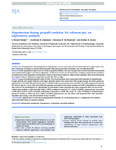Hypotension during propofol sedation for colonoscopy – an exploratory analysis
| dc.contributor.author | Sneyd, JR | |
| dc.contributor.author | Absalom, A | |
| dc.contributor.author | Barends, C | |
| dc.contributor.author | Jones, J | |
| dc.date.accessioned | 2021-10-24T21:57:22Z | |
| dc.date.issued | 2021-12-01 | |
| dc.identifier.issn | 0007-0912 | |
| dc.identifier.issn | 1471-6771 | |
| dc.identifier.uri | http://hdl.handle.net/10026.1/18160 | |
| dc.description.abstract |
Background. Intraoperative and post-operative hypotension occur commonly and are associated with organ injury and poor outcomes. Changes in blood pressure during procedural sedation are not well described. Methods. Individual patient data from five trials of propofol sedation for colonoscopy and a clinical database were pooled and explored with logistic and linear regression. A literature search and focussed meta-analysis compared the incidence of hypotension with propofol and alternative forms of procedural sedation. Hypotensive episodes were characterised by the original authors’ definitions, typically systolic blood pressure <90mmHg. Results. In pooled individual patient data (n=939), 36% of procedures were associated with episodes of hypotension. Longer periods of propofol sedation and larger propofol doses were associated with longer lasting and more profound hypotension. Amongst 380 patients for whom individual blood pressure measurements were available, 107 (28%) experienced systolic BP <90mmHg for >5 minutes and in 89 (23%) the episodes exceeded 10 minutes. Meta-analysis of eighteen Randomised Controlled Trials identified an increased Risk Ratio for the development of hypotension in procedures where propofol was used compared to the use of etomidate (2 studies, n=260, RR 2.0 [95% CI 1.37 – 2.92], p=0.0003), remimazolam (1 study, n=384, RR 2.15 [1.61 – 2.87], p=0.0001), midazolam (14 studies, n=2218, RR 1.46 [ 1.18 – 1.79], p=0.0004) or all benzodiazepines (15 studies, n=2602, 1.67 [1.41 – 1.98], p<0.00001). Hypotension was less likely with propofol than when dexmedetomidine was used (1 study, n=60, RR 0.24 [0.09 – 0.62], p=0.003). Conclusions. Hypotension is common during propofol sedation for colonoscopy and of a magnitude and duration associated with harm in surgical patients. | |
| dc.format.extent | 610-622 | |
| dc.format.medium | Print-Electronic | |
| dc.language | en | |
| dc.language.iso | en | |
| dc.publisher | Elsevier | |
| dc.subject | Sedation | |
| dc.subject | Endoscopy | |
| dc.subject | Colonoscopy | |
| dc.subject | Midazolam | |
| dc.subject | Propofol | |
| dc.subject | Hypotension | |
| dc.title | Hypotension during propofol sedation for colonoscopy – an exploratory analysis | |
| dc.type | journal-article | |
| dc.type | Review | |
| plymouth.author-url | https://www.ncbi.nlm.nih.gov/pubmed/34916051 | |
| plymouth.issue | 4 | |
| plymouth.volume | 128 | |
| plymouth.publication-status | Published | |
| plymouth.journal | British Journal of Anaesthesia | |
| dc.identifier.doi | 10.1016/j.bja.2021.10.044 | |
| plymouth.organisational-group | /Plymouth | |
| plymouth.organisational-group | /Plymouth/Faculty of Health | |
| plymouth.organisational-group | /Plymouth/Users by role | |
| dc.publisher.place | England | |
| dcterms.dateAccepted | 2021-10-17 | |
| dc.rights.embargodate | 2022-1-7 | |
| dc.identifier.eissn | 1471-6771 | |
| dc.rights.embargoperiod | Not known | |
| rioxxterms.version | Version of Record | |
| rioxxterms.versionofrecord | 10.1016/j.bja.2021.10.044 | |
| rioxxterms.licenseref.uri | http://www.rioxx.net/licenses/all-rights-reserved | |
| rioxxterms.licenseref.startdate | 2021-12-01 | |
| rioxxterms.type | Journal Article/Review |


